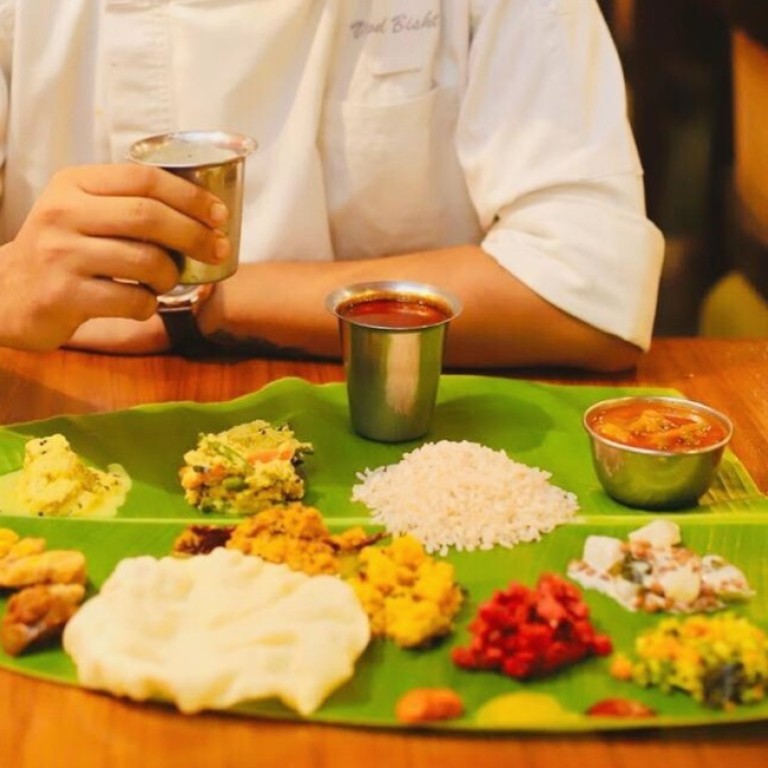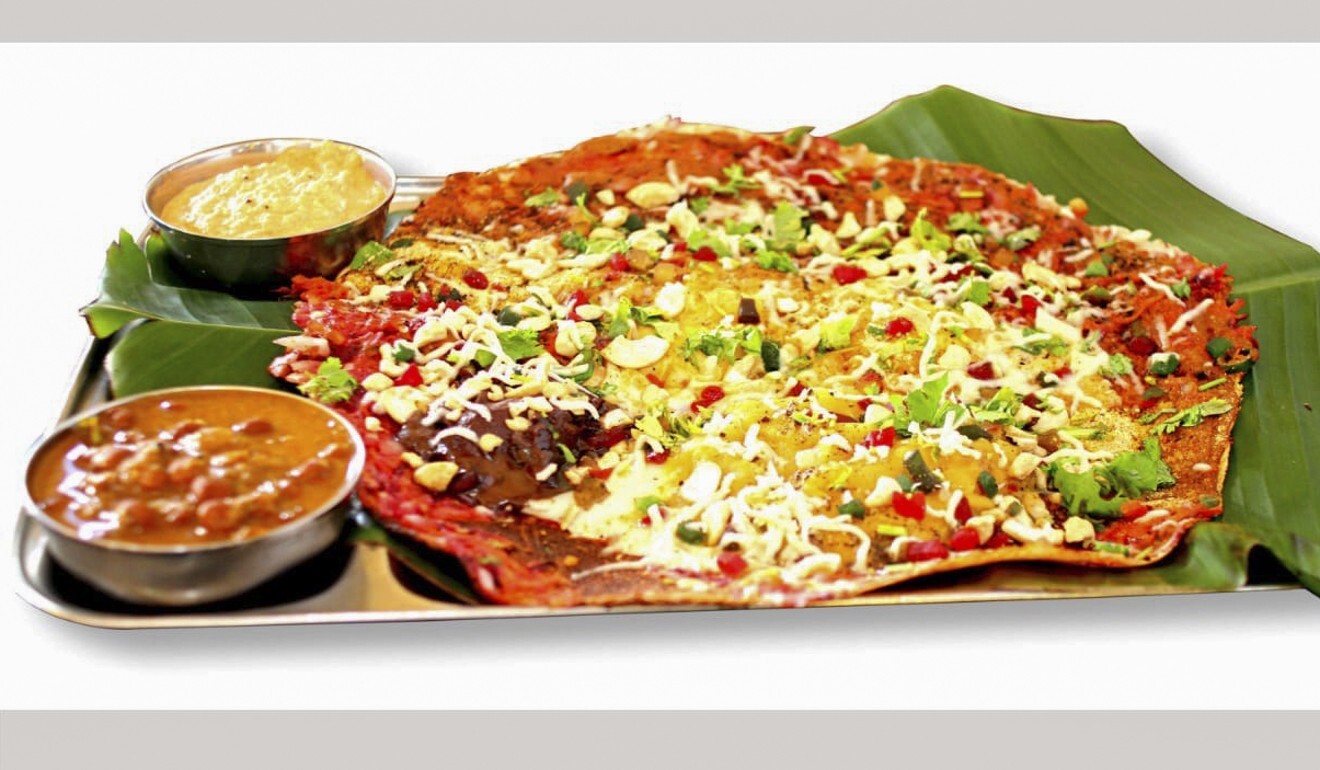
India loves dosa – just don’t tell purists about the recipes with Chinese spices, chocolate, fruit
- A street vendor’s creative take on dosa recently sparked anger among fans of the dish, which consists of a crepe usually paired with lentils, coconut chutney and rice
- But there are hundreds of versions of dosa across India and around the world, which observers say stems from its versatility and low price
An Indian street vendor unwittingly sparked a heated Twitter discussion this week after a user shared a video of him preparing an innovative version of dosa, one of the nation’s most beloved dishes.
Originating from South India, dosa is a thin pancake or crepe made from a fermented batter paired with lentils, coconut chutney and rice, that is enjoyed by millions every day.
The street vendor’s version, named “Dilkhush” (“delightful”), was crafted from ingredients such as dry fruits, cheese and sauces, outraging purists.
This is “how to screw a dosa”, one irate user said, while another critic wrote: “Please arrest this man for homicide. RIP Dosa!”
The tension kicked up a notch when users began comparing which versions of dosa were the best. Some South Indians hailed their dosa as the “original”, while northerners dubbed these comments as “snobbery”.
As the conversation grew, others around the world chimed in with their thoughts about the dish. A Malaysian commented that the dish is known as “thosai” by the country’s Indian population, while another person from Phnom Penh brought attention to a Cambodian eatery called Masala Dosa Street Kitchen that served “yummy dosas”, urging fellow Twitter users to visit them.
Observers say the wide-ranging responses to dosa underscores the reach and popularity of Indian cuisine and how migration has helped to shape culinary choices across the globe.
“Call it what you will – dosa, dosai, tosai or thosai – Indian dosa has travelled far and wide thanks to enterprising Indian migrants who have helped fuel its craze,” said Delhi-based food anthropologist Vivek Bhandari.
First mentioned by Tamil writers around 500AD, dosa travelled from the Tamil coast with the help of traders to other parts of Asia, he said.
“The idea for dosa actually came from Southeast Asia, where fermentation of many foods is quite common,” Bhandari said.
Over the years, dosa’s popularity spread largely because of restaurants and street vendors serving the dish at pocket-friendly prices.
One of its most famous fans includes British chef Gordon Ramsay, who once described dosa as “the safest and tastiest food conceived and conceptualised by humans”.
While some people swear by the original, there are hundreds of iterations of dosa, influenced by everything from Bollywood celebrities to Chinese flavours.
The most-loved versions include masala dosa with a filling of spicy mashed potatoes in the rolled-up crepe, infused with herbs like fenugreek and asafoetida, or curds and paneer.
Other popular choices include the rava dosa (made from semolina), Mysore masala dosa (a spicier version of masala dosa), paneer dosa (dosa with Indian cheese), and onion rava masala dosa.
In the southern city of Chennai, the thin and translucent 30cm-long “paper dosa” has to be served on a special steel thali, or platter, and placed on an entire table.

At the Pai Dosa restaurant in Kerala, 180 different varieties are on the menus across its outlets, including salt and pepper dosa, coconut milkshake dosa and leaf dosa.
Vinod Singh, the head chef of Jamun restaurant in Delhi’s Lodhi Colony, said the biggest reason for dosa’s popularity was its accessibility and versality.
“It can eaten for breakfast, lunch or dinner or as snack. It comes in impressive varieties, is available everywhere and is light on the stomach as well as the pocket,” he said.
New, healthier versions such as gluten-free options have helped to boost the dish’s appeal among young people, Singh noted.
“We make on-demand dosas crafted from superfoods like millets which appeal greatly to our fitness-conscious young diners,” the chef said.
From Bollywood to Szechuan
Even as relations between India and China remain testy, there is strong domestic demand across the country for dosa with Chinese influences, with Szechuan’s famed spices being a particular hit.
Szechuan dosa, Szechuan butter dosa, Szechuan masala dosa and Szechuan noodle dosa are a part of menus at many eateries in northeast India, which borders China.
“No one from China would even recognise any of these items as Chinese, but the dish is one of our top sellers,” said Rohit Tiwari, manager of the popular Sagar Ratna restaurant in Uttar Pradesh.
“We offer over a dozen types of dosas, including ‘Hot Garlic Dosa’, which has a filling of roasted garlic and vegetables, and is served with a hot sauce as well as the ‘Chinese Spring Roll Dosa’, a take on the popular Chinese spring rolls made with a filling of cabbage and carrots and served sliced up.”
Tiwari said the restaurant changed its dosa menu “every few months” to coincide with festive occasions such as Diwali, when chocolate-coated dosas are in demand.
On Indian Independence Day, the restaurant would serve “Tiranga Dosa”, or tricoloured dosa, mimicking the colours of the Indian national flag.
Meanwhile, dosa creations can also reflect cultural trends. The nation’s insatiable love for gold manifests itself in dosas coated with edible 23.5-carat-pure gold leaves. These are served at restaurants across southern cities like Hyderabad, Bangalore and Mysore, traditionally also the biggest market for gold.
The influence of Bollywood can be seen as far afield as in the US, where the “Deepika Padukone Dosa”, named after the popular actress, is on the menu at a Texas restaurant. The dish includes a potato filling and comes with ghost chilis.
Dosa has also been used to entice voters in the world’s largest democracy. During the Karnataka elections in May 2018, free dosas were served by some eateries to encourage young people to support certain candidates.
Indians have offered dosa to deities at some temples in southern states. At the Perumal Temple in Madurai, the presiding deity is offered Azhagarkoil dosa (prepared with rice and black gram dal) as the evening offering, which is distributed to devotees later.



